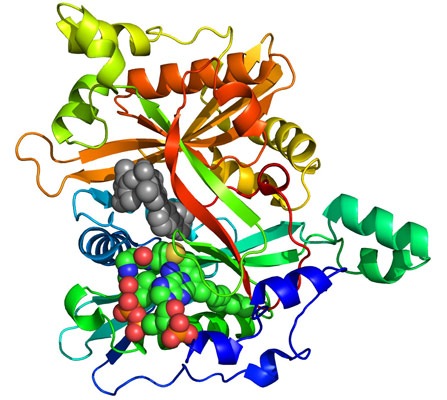- Home
- News
- General News
- New drug candidates...
New drug candidates discovered for African sleeping sickness
01-04-2010
Scientists have discovered a new potential treatment for African sleeping sickness, a disease that kills around 30,000 people each year. Laboratory tests have shown that the first of a whole range of drug candidates is highly effective at killing the parasite responsible for the disease. The structural biology that helps understand drug action and will aid future rational drug design was performed at the ESRF.
African sleeping sickness is caused by the parasitic protozoan Trypanosoma brucei and is transmitted to humans by the tsetse fly. Decoding of the Trypanosoma brucei genome has shown that it cunningly evades detection by the host’s immune system by mixing and matching its 806 genes for surface glycoprotein manufacture, allowing it to constantly disguise itself. Untreated, the disease is invariably fatal, causing around 30,000 deaths a year. Existing drug treatments are ineffective and somewhat complicated as oral versions of the drugs are lacking.
Effective drugs often act as inhibitors of a vital function in the cell of a parasite. A group of scientists from the UK and Canada has discovered that an enzyme of the parasite, N-myristoyltransferase, can be used as such a target, and they identified a range of possible drugs which inhibit the enzyme’s activity. Laboratory trials of one of the drug candidates have shown that it kills the trypanosomes in vitro and cures the disease in mice.
The contribution of the ESRF to this important result were single crystal diffraction studies at beamline ID14-1, where L. Major N-myristoyltransferase was used as a model system for the enzyme in the parasite. In these experiments, the scientists showed where the molecules bind to the enzyme and preventing the parasite from multiplying within the host (Figure 1).
The high activity of the drug target, the identification of which is the first step in development of a drug against the trypanosomes, gives hope of developing an effective treatment against the disease. Development of other drug candidates will follow to ensure optimal activity against the two stages of the disease and to ensure selectivity between human and trypanosome N-myristoyltransferases. The most promising one could be available for human trials "in around 18 months," the scientists said in a press release.
The result was published in Nature, by a team led by the Drug Discovery Unit for Tropical Diseases at the University of Dundee, Scotland. Scientists from the University of York and the Structural Genomics Consortium in Toronto also took part.
References
[1] M. Berrimann et al., Science 309, 416-422 (2005).
Principal publication and authors
J.A. Frearson (a), S. Brand (a), S.P. McElroy (a), L.A.T. Cleghorn (a), O. Smid (a), L. Stojanovski (a), H.P. Price (b), M.L.S. Guther (a), L.S. Torrie (a), D.A. Robinson (a), I. Hallyburton (a), C.P. Mpamhanga (a), J.A. Brannigan (b), A.J. Wilkinson (b), M. Hodgkinson (b), R. Hui (c), W. Qiu (c), O.G. Raimi (a), D.M.F. van Aalten (a), R. Brenk (a), I.H. Gilbert (a), K.D. Read (a), A.H. Fairlamb (a), M.A.J. Ferguson (a), D.F. Smith (b) & P.G. Wyatt (a), Nature 464, 728-732 (2010).
(a) University of Dundee (UK)
(b) University of York (UK)
(c) University of Toronto (Canada)
Top image: Trypanosome before and after treatment with the drug (scanning electron micrograph, credit University of Dundee Imaging Facility)




